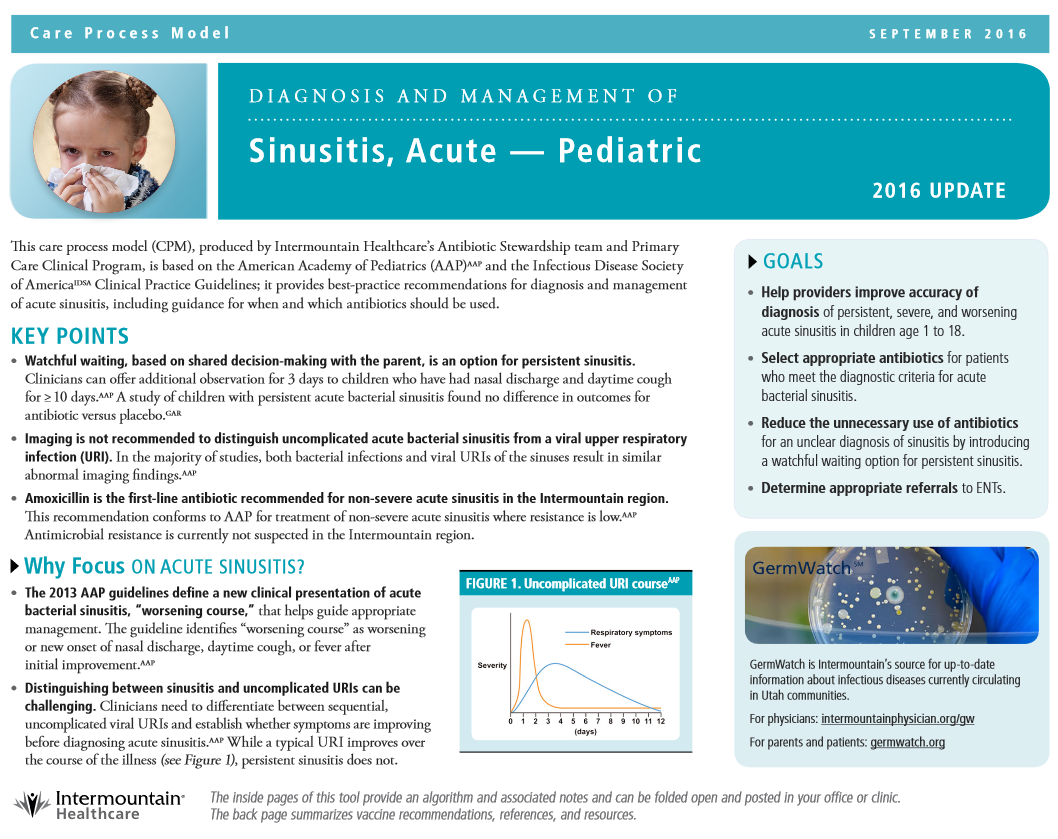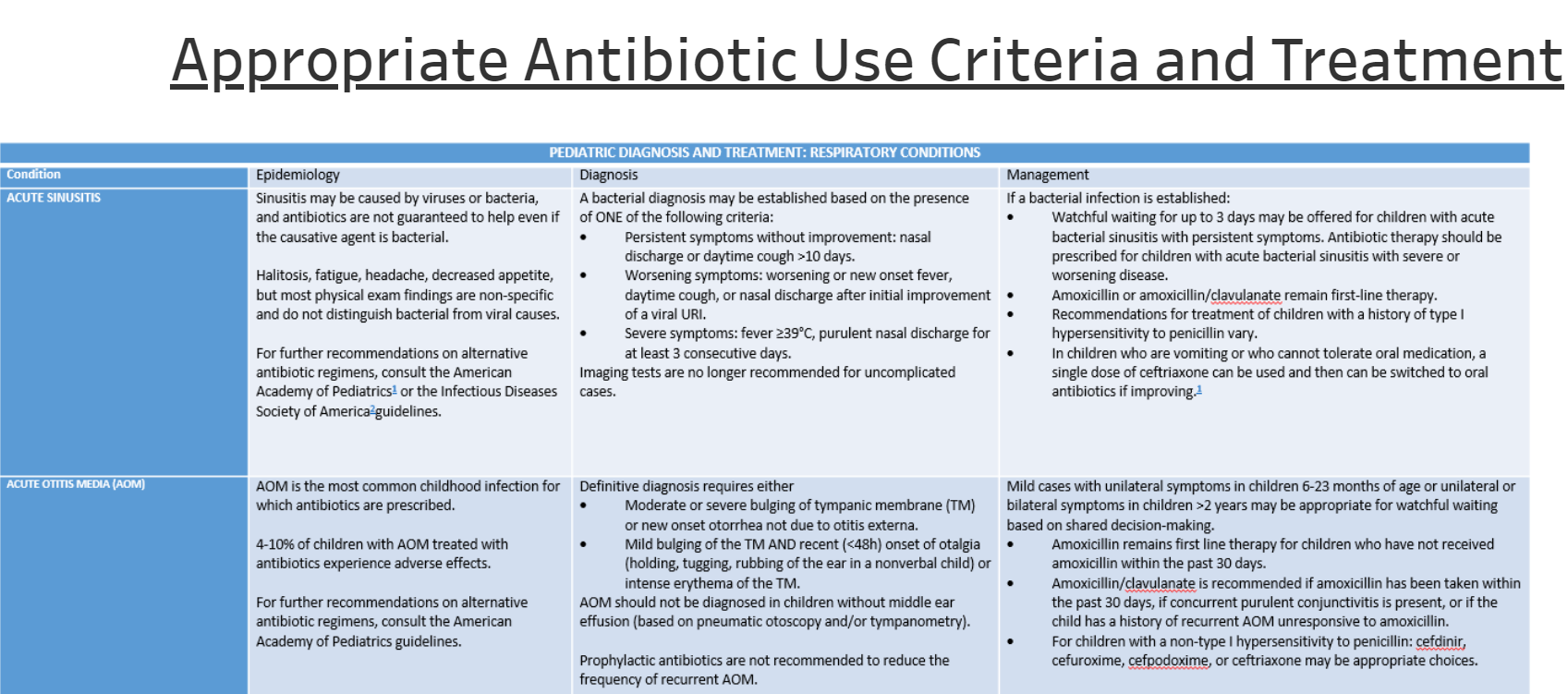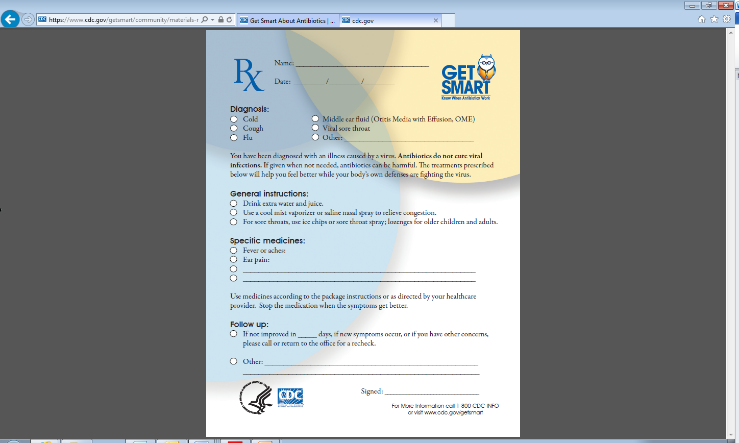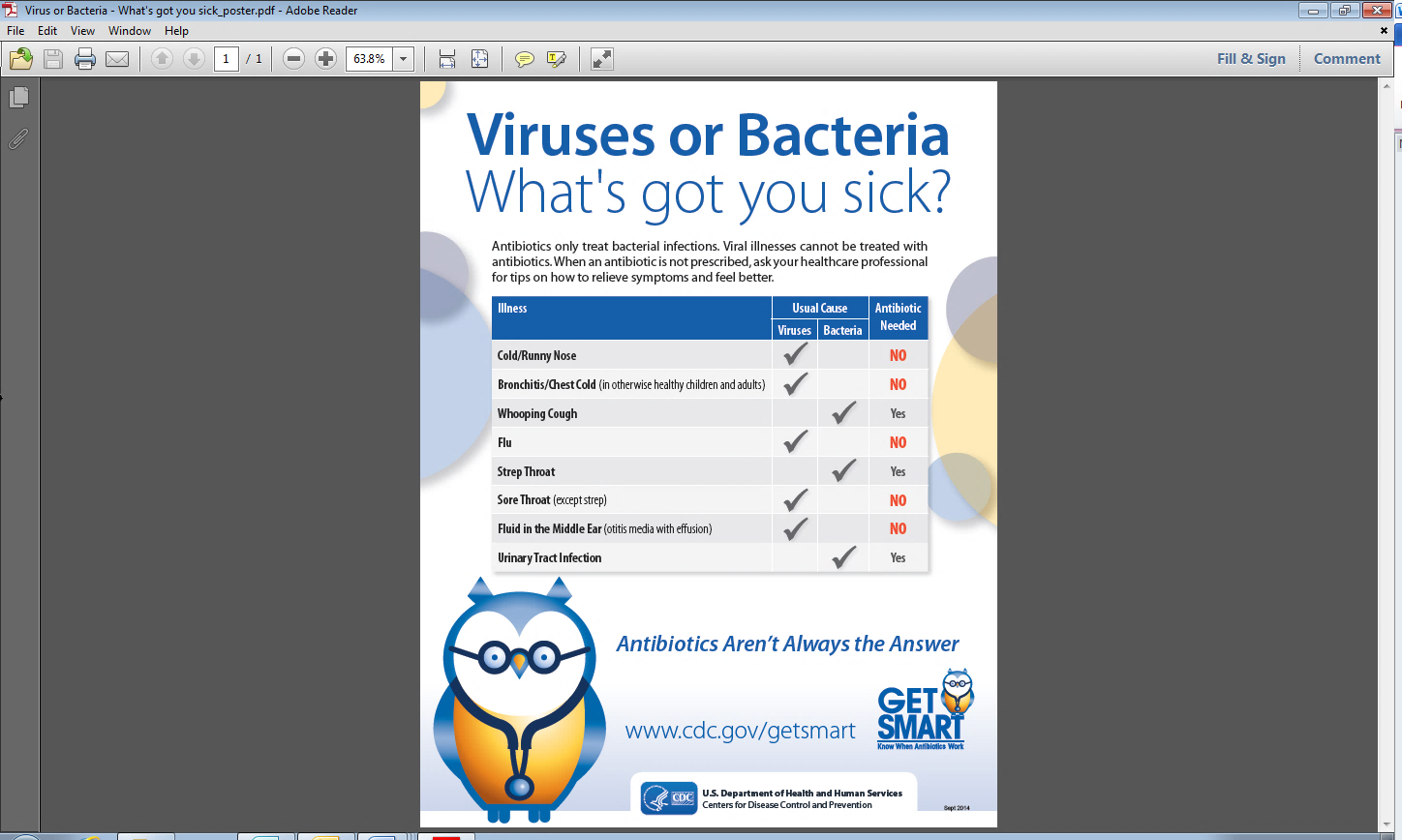0920-1071 Champions Acceptability Survey
Generic Clearance for the Collection of Qualitative Feedback on Agency Service Delivery
Peds Acceptability Survery for Clinic Champions_wFooter final
Acceptability Survey of ARI Campaign for University of Utah Pediatric Clinic Champions
OMB: 0920-1071
Form Approved
OMB No. 0920-1071
Expires 02/28/2021
Acceptability Survey of ARI Campaign for University of Utah Pediatric Clinic Champions
Title: Improving Outpatient Antibiotic Use Through Implementation and Evaluation of Core Elements of Outpatient Antibiotic Stewardship: Gauging Acceptability of Interventions of Pediatric Clinic Champions
Introduction: From January 2018 through July 2019 your clinic participated in a study of an intervention designed to improve antibiotic prescribing for acute upper respiratory tract infections (ARI) such as acute pharyngitis, acute sinusitis, acute otitis media, and non-specific upper respiratory tract infections.
The intervention (called ‘ARI Campaign’) emphasized the use of a dashboard (audit-feedback) report and academic detailing conducted by Emily Thorell, MD. MSCI.
The dashboard report included a summary of individual clinic providers’ distribution of ARI diagnoses and antibiotic prescribing patterns for treatment of ARI.
Academic detailing visits consisted of personalized one-on-one or small group educational sessions to discuss antibiotic prescribing for ARIs.
Patient education materials were provided to your clinic team at the start of the intervention. You have been identified as a site champion or peer within the facility who helped facilitate the intervention in a clinic that participated in the study.
Purpose: This survey will solicit your opinions on ARI Campaign elements and suggestions for improvement. Your responses will be used to refine delivery of the ARI Campaign and gauge acceptability of the interventional approach.
Identifiable information submitted by you will only be available to the research team, and results shared with local facility investigators or in final reports will be de-identified and reported in aggregate.
Thank you for your consideration to participate!
Instructions: Please answer the following question by selecting the values that best describe your opinions. Brief descriptions of ARI Campaign resources or activities and additional instructions will be provided in bold lettering.
Demographics
1. Which of the following best describes your role within the study clinic?
Physician or mid-level supervisor within the clinic
Other physician or mid-level provider within the clinic
Ancillary personnel within the clinic (pharmacist, clinic manager, etc.)
Other (Please Specify): Fill in the blank
_____________________________________
2. Which best describes the practice setting you most frequently work in? Please check the box below.
Primary Care
Emergency Department
Community-Based Outpatient Clinic
3. Which best describes your professional qualifications? Please check the box below.
Doctor of Medicine (MD)
Doctor of Osteopathy (DO)
Nurse Practitioner
Physician Assistant
MD/DO Resident
4. Which best describes your specialty? Please check the box below.
Internal Medicine
Emergency Medicine
Family Practice
Pediatrics
Other specialty (describe):
______________________________
5. What is your age? (Fill in the Blank)
________
6. What is your sex? Male Female
ARI Dashboard
The ARI Dashboard is a software-based information panel where personnel can view and retrieve ARI prescribing trends. During the intervention, the ARI dashboard was used to generate a provider line list with overall ARI related encounter counts and links to provider reports.
7. I accessed the ARI dashboard to review reports for the providers in my clinic.
Yes No (If no skip questions 8-11)
8. I felt the ARI dashboard report was easy to navigate. Please circle a number below.
1: |
2: |
3: |
4: |
5: |
6: |
7 |
Strongly Disagree |
|
|
Neutral |
|
|
Strongly Agree |
9. I felt the ARI dashboard report was easy to understand. Please circle a number below.
1: |
2: |
3: |
4: |
5: |
6: |
7 |
Strongly Disagree |
|
|
Neutral |
|
|
Strongly Agree |
10. I felt the ARI dashboard met my expectations for generating feedback for providers concerning clinical practices for ARIs. Please circle a number below.
1: |
2: |
3: |
4: |
5: |
6: |
7 |
Strongly Disagree |
|
|
Neutral |
|
|
Strongly Agree |
11. I had sufficient time to periodically review dashboard reports for providers. Please circle a number below.
1: |
2: |
3: |
4: |
5: |
6: |
7 |
Strongly Disagree |
|
|
Neutral |
|
|
Strongly Agree |
Dashboard Reports
Dashboard reports included a summary of individual providers’ distribution of ARI diagnoses and antibiotic prescribing patterns for treatment of ARI. These reports were delivered via a link and accompanied with individualized feedback on how to improve ARI management.
12. I disseminated or discussed dashboard reports to the providers in my clinic.
Yes No (If no skip questions 13-21)
13. I disseminated or discussed dashboard reports through the following mediums.
E-mail In-Person Both (Please explain)
14. I had sufficient time to periodically review and/or disseminate dashboard reports. Please circle a number below.
Strongly disagree: 1: 2 : 3 : 4 : 5 : 6 : 7 : Strongly agree
15. I understood the content of the dashboard report and how the data related to prescribing practices of providers. Please circle a number below.
Strongly disagree: 1: 2 : 3 : 4 : 5 : 6 : 7 : Strongly agree
16. I felt the use of peer comparison within the dashboard report was meaningful for providing insight concerning the prescribing practices of providers at my clinic. Please circle a number below.
1: |
2: |
3: |
4: |
5: |
6: |
7 |
Strongly Disagree |
|
|
Neutral |
|
|
Strongly Agree |
17. During dissemination / discussion of dashboard reports, I provided an interpretation of the major findings from reports to individual clinicians. Please circle a number below.
1: |
2: |
3: |
4: |
5: |
6: |
7 |
Strongly Disagree |
|
|
Neutral |
|
|
Strongly Agree |
18. I felt the data within dashboard reports accurately reflected prescribing patterns of providers. Please circle a number below.
1: |
2: |
3: |
4: |
5: |
6: |
7 |
Strongly Disagree |
|
|
Neutral |
|
|
Strongly Agree |
19. I was comfortable in discussing dashboard reports with providers. Please circle a number below.
1: |
2: |
3: |
4: |
5: |
6: |
7 |
Strongly Disagree |
|
|
Neutral |
|
|
Strongly Agree |
20. Providers were receptive to receiving and discussing the dashboard reports. Please circle a number below.
1: |
2: |
3: |
4: |
5: |
6: |
7 |
|
Strongly Disagree |
|
|
Neutral |
|
|
Strongly Agree |
|
21. How much time did you spend discussing/or disseminating reports in aggregate for the providers within your clinic.
________ Hours per clinic audit/feedback event Not applicable
Academic Detailing Training & Academic Detailing Sessions
Academic detailing visits consisted of personalized one-on-one or small group educational sessions to discuss antibiotic prescribing for ARIs.
22. I facilitated academic detailing to providers within a study clinic concerning ARI management.
Yes No (If no skip questions 23-26)
23.It was difficult to facilitate scheduling a time to meet with providers for a one-on-one meeting with the antimicrobial steward.
1: |
2: |
3: |
4: |
5: |
6: |
7 |
|
Strongly Disagree |
|
|
Neutral |
|
|
Strongly Agree |
|
24. Communication with the provider during the academic detailing sessions was conversational.
1: |
2: |
3: |
4: |
5: |
6: |
7 |
|
Strongly Disagree |
|
|
Neutral |
|
|
Strongly Agree |
|
25. Academic detailing sessions uncovered additional insight on ARI management by providers that supplemented the dashboard reports.
1: |
2: |
|
3: |
4: |
5: |
6: |
7 |
|
Strongly Disagree |
|
|
|
Neutral |
|
|
Strongly Agree |
|
26. What comments/suggestions do you have concerning the use of dashboard reports and academic detailing for ARI Management? (Short answer)
Gauging Additional Intervention Components
Other available ARI Campaign tools included: Intermountain Care Process Model, the ARI Quick Reference Chart in the Dashboard Report, and Patient Education Handouts. Please answer the following questions on the usefulness of these tools.
Intermountain Care Process Model



Quick Reference Chart in the dashboard report - provides current guidelines concerning diagnosis, prescribing, and preferred therapy.

Patient Education. Patient education handouts concerning the appropriate use of antibiotics within ARIs.



27. How important do you feel these intervention components are to enable providers to improve antimicrobial stewardship in your clinic? Please circle a number below.
1: |
2: |
3: |
4: |
5: |
6: |
7 |
|
Unimportant |
|
|
Sometimes |
|
|
Important |
|
28. Based on interactions with providers, rank the likely impact of the following ARI Campaign components on behaviors to improve antimicrobial stewardship. Please circle a number below.
Kick-Off Presentation |
1: |
2: |
3: |
4: |
5: |
6: |
7 |
Low Impact |
|
|
Neutral |
|
|
High Impact |
|
Dashboard Reports |
1: |
2: |
3: |
4: |
5: |
6: |
7 |
Low Impact |
|
|
Neutral |
|
|
High Impact |
|
One-on-one Academic Detailing |
1: Low Impact |
2: |
3: |
4: Neutral |
5: |
6: |
7 Low Impact |
Care Process Models |
1: |
2: |
3: |
4: |
5: |
6: |
7 |
Low Impact |
|
|
Neutral |
|
|
High Impact |
|
Patient Education Handouts |
1: |
2: |
3: |
4: |
5: |
6: |
7 |
Low Impact |
|
|
Neutral |
|
|
High Impact |
Fidelity and Sustainability. Please answer the following questions with regards to interactions with site investigators and/or current stewards associated with the ARI Campaign.
29. During the ARI Campaign, the dashboard reports were supposed to be delivered through e-mail or during an initial academic detailing visit. Reports were then supposed to be delivered every 2-3-month intervals for providers who received a baseline report. During the ARI Campaign, were you provided reports in this described format?
Yes No (If yes please explain)
30. Academic detailing was supposed to be provided as one-on-one, or in small groups by Dr. Thorell. Additional academic detailing visits were encouraged for providers who did not improve performance after the initial reports. These academic detailing conversations were intended to be guided by the dashboard report. During the ARI Campaign did you also provided academic detailing?
Yes No (If yes please explain)
31. I feel the frequency and quality of contact with the site investigator and/or antimicrobial steward each quarter was sufficient to implement intervention activities at my site. Please circle a number below.
1: |
2: |
3: |
4: |
5: |
6: |
7 |
|
Strongly Disagree |
|
|
Neutral |
|
|
Strongly Agree |
|
32. I feel that the delivery of dashboard reports and academic detailing for ARIs could be conducted on a seasonal basis (October-March) each year as opposed to a continual (year-round) basis. Please circle a number below.
1: |
2: |
3: |
4: |
5: |
6: |
7 |
|
Strongly Disagree |
|
|
Neutral |
|
|
Strongly Agree |
|
33. I feel that I need the continued support of the antimicrobial steward and/or site investigator to continue ARI Campaign related activities at my site. Please circle a number below.
1: |
2: |
3: |
4: |
5: |
6: |
7 |
|
Strongly Disagree |
|
|
Neutral |
|
|
Strongly Agree |
|
Please provide any additional comments or suggestions concerning the ARI Campaign. (Short Answer)
THANK YOU FOR YOUR TIME!
Public reporting burden of this collection of information is estimated to average 30 minutes per response, including the time for reviewing instructions, searching existing data sources, gathering and maintaining the data needed, and completing and reviewing the collection of information. An agency may not conduct or sponsor, and a person is not required to respond to a collection of information unless it displays a currently valid OMB control number. Send comments regarding this burden estimate or any other aspect of this collection of information, including suggestions for reducing this burden to CDC/ATSDR Information Collection Review Office, 1600 Clifton Road NE, MS D-74, Atlanta, Georgia 30333; ATTN: PRA (0920-1071).
Page
Version 1 (02/28/2019)
| File Type | application/vnd.openxmlformats-officedocument.wordprocessingml.document |
| File Modified | 0000-00-00 |
| File Created | 0000-00-00 |
© 2025 OMB.report | Privacy Policy